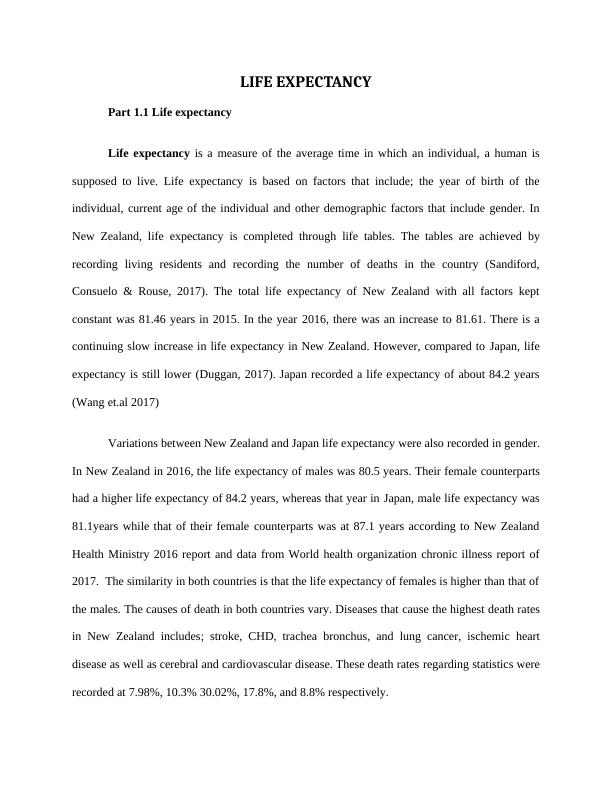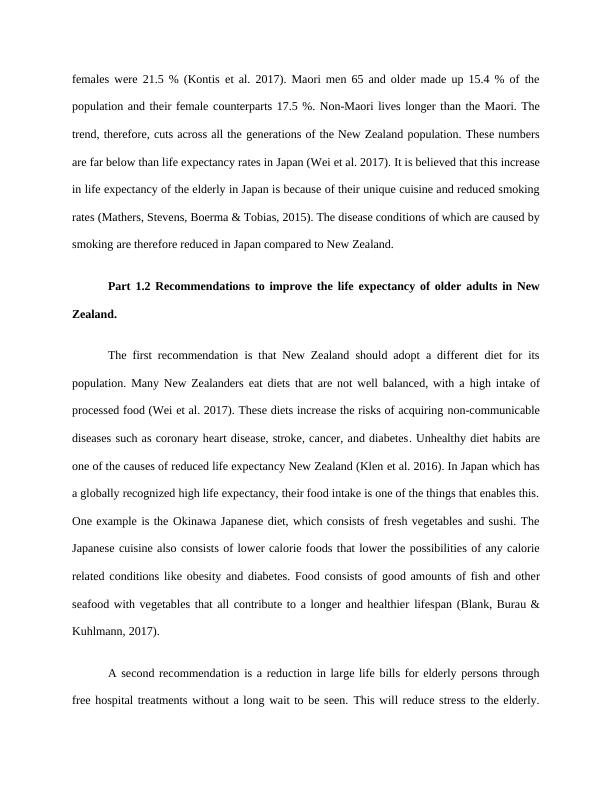Ask a question from expert
Life expectancy Assignment PDF
11 Pages2892 Words129 Views
Added on 2021-10-13
Life expectancy Assignment PDF
Added on 2021-10-13
BookmarkShareRelated Documents

LIFE EXPECTANCY
Part 1.1 Life expectancy
Life expectancy is a measure of the average time in which an individual, a human is
supposed to live. Life expectancy is based on factors that include; the year of birth of the
individual, current age of the individual and other demographic factors that include gender. In
New Zealand, life expectancy is completed through life tables. The tables are achieved by
recording living residents and recording the number of deaths in the country (Sandiford,
Consuelo & Rouse, 2017). The total life expectancy of New Zealand with all factors kept
constant was 81.46 years in 2015. In the year 2016, there was an increase to 81.61. There is a
continuing slow increase in life expectancy in New Zealand. However, compared to Japan, life
expectancy is still lower (Duggan, 2017). Japan recorded a life expectancy of about 84.2 years
(Wang et.al 2017)
Variations between New Zealand and Japan life expectancy were also recorded in gender.
In New Zealand in 2016, the life expectancy of males was 80.5 years. Their female counterparts
had a higher life expectancy of 84.2 years, whereas that year in Japan, male life expectancy was
81.1years while that of their female counterparts was at 87.1 years according to New Zealand
Health Ministry 2016 report and data from World health organization chronic illness report of
2017. The similarity in both countries is that the life expectancy of females is higher than that of
the males. The causes of death in both countries vary. Diseases that cause the highest death rates
in New Zealand includes; stroke, CHD, trachea bronchus, and lung cancer, ischemic heart
disease as well as cerebral and cardiovascular disease. These death rates regarding statistics were
recorded at 7.98%, 10.3% 30.02%, 17.8%, and 8.8% respectively.

These numbers compared to Japan is entirely different. In Japan, the trends are lower
with a percentage of 15.6% for trachea bronchus and lung cancer, 16.01% for ischemic heart
disease and 8.4% for the cerebral and cardiovascular disease. These trends are because of the
course of action that Japan has taken on their older population (Miranda, 2018). The death rate
due to cancer is double in New Zealand compared to Japan
A disease that causes mortality in New Zealand
1
.
Cancer 30.02%
2
.
Ischemic heart disease 17.8%
3
.
Cerebrovascular disease 8.8%
A disease that causes mortality in Japan
1
.
Cancer 15.6%
2
.
Ischemic heart disease 16.01%
3
.
Cerebral vascular disease 8.4%
In New Zealand, in the population 65 years and older, the percentage of non-Maori is
higher than the Maori. From 2012 to 2017, non-Maori males were at 19.4 %, while non-Maori

females were 21.5 % (Kontis et al. 2017). Maori men 65 and older made up 15.4 % of the
population and their female counterparts 17.5 %. Non-Maori lives longer than the Maori. The
trend, therefore, cuts across all the generations of the New Zealand population. These numbers
are far below than life expectancy rates in Japan (Wei et al. 2017). It is believed that this increase
in life expectancy of the elderly in Japan is because of their unique cuisine and reduced smoking
rates (Mathers, Stevens, Boerma & Tobias, 2015). The disease conditions of which are caused by
smoking are therefore reduced in Japan compared to New Zealand.
Part 1.2 Recommendations to improve the life expectancy of older adults in New
Zealand.
The first recommendation is that New Zealand should adopt a different diet for its
population. Many New Zealanders eat diets that are not well balanced, with a high intake of
processed food (Wei et al. 2017). These diets increase the risks of acquiring non-communicable
diseases such as coronary heart disease, stroke, cancer, and diabetes. Unhealthy diet habits are
one of the causes of reduced life expectancy New Zealand (Klen et al. 2016). In Japan which has
a globally recognized high life expectancy, their food intake is one of the things that enables this.
One example is the Okinawa Japanese diet, which consists of fresh vegetables and sushi. The
Japanese cuisine also consists of lower calorie foods that lower the possibilities of any calorie
related conditions like obesity and diabetes. Food consists of good amounts of fish and other
seafood with vegetables that all contribute to a longer and healthier lifespan (Blank, Burau &
Kuhlmann, 2017).
A second recommendation is a reduction in large life bills for elderly persons through
free hospital treatments without a long wait to be seen. This will reduce stress to the elderly.

End of preview
Want to access all the pages? Upload your documents or become a member.
Related Documents
Life Expectancy in New Zealand and Japan: A Comparisonlg...
|11
|2883
|257
New ZEALAND EPIDEMIOLOGY: A new approach to epidemiologylg...
|20
|5397
|77
Motor-skill learning in older adults PDFlg...
|10
|2775
|77